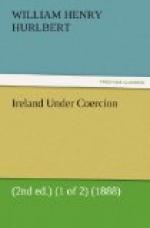After luncheon we walked with Mr. Herdman through the mills and the model village which has grown up around them. Everywhere we found order, neatness, and thrift. The operatives are almost all people of the country, Catholics and Protestants in almost equal numbers. “I find it wise,” said Mr. Herdman, “to give neither religion a preponderance, and to hold my people of both religions to a common standard of fidelity and efficiency.” The greatest difficulty he has had to contend with is the ineradicable objection of some of the peasantry to continuous industry. He told us of a strapping lass of eighteen who came to the mills, but very soon gave up and went back to the parental shebeen in the mountains rather than get up early in the morning to earn fourteen shillings a week.
Three weeks of her work would have paid the year’s rent of the paternal holding.
In the village, which is regularly laid out, is a reading-room for the workpeople. There are cricket clubs, and one of the mill buildings (just now crammed with bales of flax) has been fitted up by Mr. Herdman as a theatre. There is a drop-curtain representing the Lake of Como, and the flies are flanked by life-size copies in plaster of the Apollo Belvidere and the Medicean Venus. This is a development I had hardly looked to see in Ulster.
After we had gone over the works thoroughly, Mr. Herdman took us back, on a transparent pretext of enlightened curiosity touching certain qualities of spun flax, to give us a glimpse of the “beauty of Sion”—a well-grown graceful girl of fifteen or sixteen summers. She concentrated her attention, as soon as we appeared, upon certain mysterious bobbins and spindles, with an exaggerated determination which proved how completely she saw through our futile and frivolous devices. Mr. Herdman told us, as we came away discomfited, a droll story of the ugliest girl ever employed here—a girl so preternaturally ugly that one of his best blacksmiths having been entrapped into offering to marry her, lost heart of grace on the eve of the sacrifice, and, taking ship at Derry for America, fled from Sion for ever.




